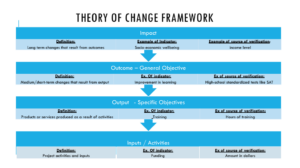The Importance of Measuring Impact in the Social Sector
Why is important measuring impact in the social sector?
In the social sphere, any activities undertaken pursue certain objectives and seek to produce an impact on the target group they are intended for. The impact refers to the benefits, changes or improvements the outcomes of the activity/program have brought to the lives of the beneficiaries.
It is undeniable that measuring the impact produced is beneficial for both the organization that delivers the activities and its stakeholders, and the relationship between these two. Measuring the impact will help us determine the effectiveness of our actions and evaluate the need to adjust our services/programs.
An article from the Minneapolis Fed sums it up: “If organizations don’t measure their impact, they risk not being able to demonstrate the effectiveness of their programs.”
The risks of those who do not measure the impact in the social sector/h2>
Without any measurement, there is a risk that the beneficiaries of such programs don’t see any improvement in their lives, or merely experience a temporary improvement while the program lasts.
Thus, there is a risk that the long-term problems of these people remain and that the proposed activities don’t offer any satisfying solution to the troubles they are facing (social integration or reintegration, depression, lack of physical and/or psychological autonomy…). For the reasons we just exposed, as well as for financial and ethical reasons, it is important to measure the impact of these activities and rebuild them if necessary.
We believe that the implementation of some exercises and discussions will help to embed a conscious measurement of the impact of community work and social activities. Although for the process to be efficient and interesting, collaboration and help towards each other are needed: “With man being a social being, one can never separate himself not only from his immediate community but to the larger society as well.” The same applies to smaller working groups.
And who has a better position than the beneficiaries themselves to measure such impacts? Through reflections about human relationships, current life situations, the meaning of abuse or justice at the workplace, and a safe space provided by a trainer, where people listen without judgment, give their opinion, and where the facilitator’s only purpose is to help to overcome difficulties, the consequences of the activities’ impacts will come to the surface naturally.
The Theory of Change Model
Although many people taking part in social activities would rather say that they like it and it helps them overcome loneliness, depression or inactivity, we don’t have efficient tools available to measure the impact of such activities.
Social relationships are often complex, and it is not sure whether social integration is truly a benefit for some people. So, how can it be possible to measure the impact of these activities?
Impact measurement has to be seen as a process that undergoes certain planning rather than a one-time event.
A model called the theory of change shows and explains the link between the activities being undertaken and their targeted outcomes and impact:
- Input: the supply of resources to carry out the activity. These may be financial, intellectual, human, etc. They can also refer to buildings, premises, etc.
- Activity: the work was undertaken using the resources to achieve a given outcome.
- Output: the points of contact of the activities with the beneficiaries, e.g. attending a course/program, using a certain product produced for the beneficiaries, receiving a certain treatment.
- Outcome: what was achieved with the service/product; changes achieved in the lives of the beneficiaries (direct service users and other stakeholders: their families, communities, etc.) arising as a result of the activities undertaken.
- Impact: the value a stakeholder achieves through a given service or product supplied. To measure the impact it is necessary to determine the extent to which outcomes can be attributed to the specific activities delivered by that social enterprise.

Measuring impact in the social sector, thanks to the theory of change, allows working with groups of people to enrich us and bring to light the needs and impacts of the entire social spectrum without exception.
If you want to understand more about how stories’ impact can be measured do not hesitate to read the Toolkit
